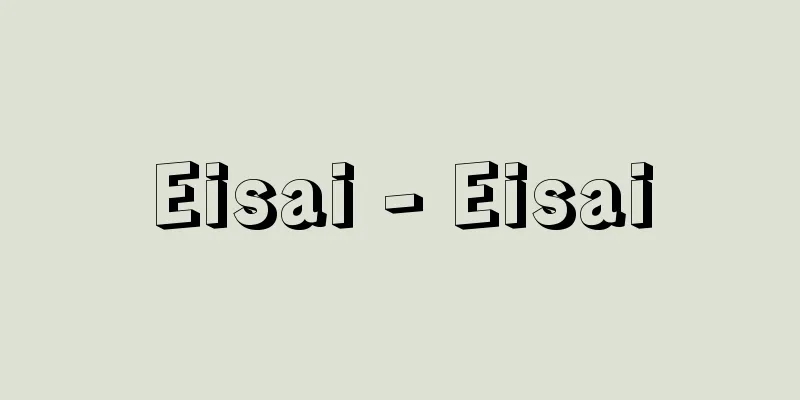Eisai - Eisai

|
A monk from the Kamakura period. He is considered to be the founder of the Rinzai sect of Buddhism in Japan. He is also known as Yojo-ryu of Taimitsu (Tendai Esoteric Buddhism). He was also known as Yojo-bo, Senko Kokushi, and Chikongo, and his Zen nickname was Myoan. [Muneto Taga, May 19, 2017] Life and AchievementsHe was a member of the Kaya clan, a priest at Kibitsu Shrine in Bitchu (Okayama Prefecture). He was born on April 20th (some say the 25th) in the 7th year of the Hoen era. In 1151 (Nihei 1), he aspired to become a Buddhist and entered Enryaku-ji Temple on Mount Hiei to study esoteric Buddhism. In 1162 (Oho 2), he returned to his hometown to practice asceticism, and then entered Mount Hiei again to receive the initiation ceremony. During this time, he studied under Seishin (?-1157), Senmei, Yuben, Kiko, and Ken'i. From an early age, Eisai had a strong desire for the flourishing of Buddhism in Japan, and in particular, hoping to study Buddhism on the continent, he aspired to travel to Song China to seek the Dharma. In 1167 (Jin'an 2), at the age of 27, he went to Kyushu, and the following year in 1168, he traveled to Song China. It is said that this journey was under the patronage of Taira no Yorimori. In Song China, Eisai first studied at Mount Tiantai and Mount Ashoka, and also inquired about the essence of Zen, staying there for six months before returning to Japan the same year, during which time he became acquainted with Shunjobo Chogen. After returning to Japan, he submitted commentaries he had received from the continent to Mount Hiei, and then traveled around his hometown for six years. Around 1175 (Angen 1), he went to Kyushu again and stayed at Seiganji Temple in Imazu, Chikuzen (Fukuoka Prefecture) for 10 years. During this time, he studied esoteric Buddhism and Zen while waiting for the arrival of the complete Buddhist scriptures he had sought from the continent. In particular, about 10 writings written around this time show that he paid special attention to An'nen, who perfected Tendai esoteric Buddhism. In 1187 (Bun'ei 3), at the age of 47, he made his second visit to Song China. This time, he wanted to make a pilgrimage to Buddhist sites, but the Song court did not permit it. Instead, he passed through Zui'an and entered Mount Tiantai, where he studied under Koan Esho (date of birth and death unknown) at Mannen-ji Temple, and then accompanied his teacher to Mount Tendo, where he received Zen from the Huanglong school of the Rinzai sect. Among the Japanese monks who went to Song China, Eisai was the only one who directly accepted this sect. It is said that Eisai also taught Esoteric Buddhism to Kaicho during this time. He returned to Japan in 1191 (Kenkyu 2), and traveled to Hizen (Nagasaki Prefecture) and Hirado, spreading the teachings throughout Kyushu, where he worked on building Zen temples, promoting Zen teachings, and copying sutras and treatises. During this time, he brought tea seeds from Song China and planted them on Sefuriyama, which lies on the border between Chikuzen and Hizen, and this is considered to be the birthplace of tea cultivation and its spread in Japan. In 1194 (Kenkyu 5), he went to Kyoto to spread his teachings, and it is said that he wrote "Kōzen Gokokuron" (Promoting Zen and Protecting the Nation) during this period. At that time, Kakua, Dainichi Nounin and others were already preaching the "Dharma sect" in the capital and promoting Zen, and their novel teachings were attracting attention from the public, but the monks of Mount Hiei interfered with their propagation. Eisai's teachings also came under pressure from Mount Hiei, and an imperial decree was issued to suspend them, so Eisai went down to Kyushu for a time. It was at this time that he built Shofuku-ji Temple on Mount Ankoku in Hakata, which, together with the later Kennin-ji Temple in Kyoto and Jufuku-ji Temple in Kamakura, are the great Zen temples that Eisai left to this day. He returned to Kyoto in the same year, but he was once again prepared and ready to face misunderstandings from the public and pressure from the old powers. Half of the arguments in his new work, "Kyo Zen Gokoku Ron," also prepares for attacks from Mount Hiei, stating that Eisai's Zen is a modern adaptation of the Zen tradition handed down by Saicho. However, at the same time, there are signs that he was seeking understanding and support from within the Imperial Court. Eisai wrote "Kyo Zen Gokoku Ron" in 1198 (Kenkyu 9), and to avoid unnecessary friction, he temporarily left the capital the following year in 1199 to seek a new frontier for missionary work in Kamakura. Eisai, who had traveled to the Song Dynasty, was soon welcomed by the Shogun and the Shogunate and was commissioned to perform prayers, and in 1202 (Kennin 2), Hojo Masako built Jufuku-ji Temple for Eisai and appointed him as its chief priest. He then returned to the capital and built Kennin-ji Temple under the patronage of Shogun Minamoto no Yoriie. It is said that the Imperial Court also listed it as an official temple. It is believed that Eisai made Kennin-ji Temple a training center for the three teachings of Shingon, Shikan, and Zen, intending to harmonize with the old powers, but here the Rinzai sect was established as a new major sect in Japan, with Kyoto and Kamakura as its strong bases, and Eisai, at the age of 62, had accomplished something that marked a new era in the history of Japanese Buddhism. From then on, Eisai spent the last 10 years of his life as an elder in charge of overseeing the large temples in Kyoto and Kamakura. He demonstrated practical skills in a wide range of social activities, while at the same time consolidating and publishing his experiences and thoughts, engaging in ideological activities that benefited the public and future generations. At the time, the restoration of Nara was underway as a major national project that brought together the efforts of the Imperial Court, the military, and the government. When Shunjobo Chogen, who had worked tirelessly as a promoter of the construction of Todaiji Temple for over a decade until this time, passed away in 1206 (Ken'ei 1), the Imperial Court appointed Eisai as his successor. Part of Eisai's activities and achievements can be seen in the construction of the halls and gates, but it is also noteworthy that some of the few handwritten letters that remain today from Eisai show his activities that year. It was also around this time that he received orders from the Imperial Court to restore the nine-story pagoda of Hoshoji Temple in Kyoto, which had been burned down by lightning. The Imperial Court rewarded Eisai for his achievements by appointing him to the titles of Hoin and Gon no Sojo, but it is said that Eisai himself later requested the title Daishi. During this time, he was active not only in Kyoto but also in Kamakura. He became acquainted with the Shogun Minamoto no Sanetomo, and the two men often had Buddhist discussions. Eisai's final work, Kissa Yojoki, was compiled as a result of these discussions. He passed away on June 5th (or July) of the third year of Kenpo at the age of 75, and there are two legends regarding the place of his death - Kyoto and Kamakura - and it is still debated to this day which of these is the correct one. [Muneto Taga, May 19, 2017] ThoughtEisai believed in Taimitsu esoteric Buddhism throughout his life, and founded a sect that incorporated the ideas of Eastern Esoteric Buddhism, which is considered the founder of the Hae school. His only work on Zen was "Kyozen Gokokuron" (The Treatise on Revitalizing Zen and Protecting the Nation), written at the age of 58, which is notable for its emphasis on the precepts as the foundation of Zen. This idea was embodied in "Shukke Taikou" (Outline for Religious Cultivation), which explained the practice of precepts in daily life, and other works that are said to have been written by Eisai, such as "Saikai Kanjinmon" (A Letter on Enacting Precepts) and "Endon Sanju Isshinkai" (A Letter on the Revival of Japanese Buddhism), written at the age of 64, in which he appealed for the aspiration to promote the rise of Buddhism and lamented the decline of the observance of precepts in society. His disciples included Eichou (1165-1247) and Gyoyu, who spread the sect's style of practicing both Tendai and Zen to the Kanto region. Kenninji Temple was home to Myozen (1184-1225) and Dogen, who inherited the throne and head priesthood. It is widely known that Dogen's Shobogenzo Zuimonki records Eisai's noble and pure sensibility, but it is questionable whether Eisai and Dogen ever met. [Muneto Taga, May 19, 2017] "The Zen Master Eisai" by Yasuhiko Kimiya (1916, Heigo Publishing Co., Ltd. / 1977, Kokusho Kankokai)" ▽ "Eisai" by Sojun Taga (1965 / New edition, 1986, Yoshikawa Kobunkan)" [References] | | | | |Kenninji | | | | | |Volume 1, by Eisai, published in the National Diet Library "Coffee House Regimen" Source: Shogakukan Encyclopedia Nipponica About Encyclopedia Nipponica Information | Legend |
|
鎌倉時代の僧。日本臨済(りんざい)宗の開祖とされる。台密(たいみつ)(天台密教)葉上(ようじょう)流の祖。「ようさい」ともいう。葉上房(ようじょうぼう)、千光(せんこう)国師、智金剛と称し、禅宗の字(あざな)は明庵(みょうあん)。 [多賀宗隼 2017年5月19日] 生涯・業績備中(びっちゅう)(岡山県)の吉備津(きびつ)神社の神職賀陽(かや)氏の出身。保延(ほうえん)7年4月20日(一説に25日)生まれる。1151年(仁平1)仏道を志して比叡山(ひえいざん)延暦寺(えんりゃくじ)に入り密教を学んだ。1162年(応保2)いったん帰郷して修行したのち、ふたたび叡山に入って灌頂(かんじょう)を受けた。この間、静心(じょうしん)(?―1157)、千命(せんめい)、有弁(ゆうべん)、基好(きこう)、顕意(けんい)に師事した。早くから日本の仏法の興隆を深く願ったが、とくに大陸仏法の学習に期待して入宋求法(にっそうぐほう)の志を抱き、1167年(仁安2)27歳にして九州に赴き、翌1168年渡宋した。この行については平頼盛(たいらのよりもり)の外護(げご)があったとも伝えられる。宋において、栄西は初め天台山、阿育王(あいくおう)山などに学び、また禅の要旨を問い、滞在6か月に及んで同年帰国したが、その間に俊乗房重源(しゅんじょうぼうちょうげん)と面識を得た。帰朝後、叡山に大陸から将来した章疏(しょうそ)を納め、ついで故郷方面で6年間巡錫(じゅんしゃく)した。1175年(安元1)ころ、ふたたび九州に赴き、筑前(ちくぜん)(福岡県)今津の誓願寺(せいがんじ)などに滞在すること10年に及んだ。この間、大陸に求めた一切経(いっさいきょう)の到来を待ちつつ、密教と禅の研究に努めた。とくに、天台密教を大成した安然(あんねん)に注目していることがこのころ成った約10部の著述に示されている。1187年(文治3)47歳で第2回目の入宋を実現した。このときは仏跡巡礼を志したが宋の朝廷に許されず、瑞安(ずいあん)を経て天台山に入り、万年寺で虚庵懐敞(こあんえしょう)(生没年不詳)に師事し、師に随(したが)って天童山に移って臨済宗黄龍派(おうりゅうは)の禅を受けた。日本の入宋僧のなかで直接にこの派を受けたのは栄西のみである。またこのとき、栄西は懐敞に密教を伝えたという。 1191年(建久2)に帰国し、肥前(ひぜん)(長崎県)平戸を経て九州各地に弘法(ぐほう)し、禅寺の建立、禅規の興行、経論の書写などに努めた。そのおり、宋よりもたらした茶種を筑前、肥前の境にある脊振山(せふりやま)に植えたが、それが日本の茶の栽培、普及の発祥地とされている。1194年(建久5)布教のために上京、『興禅護国論(こうぜんごこくろん)』の起稿はこの途上のこととの説もある。このころ、都ではすでに覚阿(かくあ)、大日能忍(だいにちのうにん)らが「達磨宗(だるましゅう)」を説いて禅を鼓吹しており、その新奇の教えが世人の視聴をそばだてていたが、叡山の衆徒はその布教に妨害を加えた。栄西の教えもこれとともに叡山の圧迫を受け、停止(ちょうじ)の宣旨(せんじ)が出されたため、栄西はいったん九州に下向した。博多(はかた)に安国山聖福寺(しょうふくじ)を建てたのはこのときであるが、これはのちに建立された京都の建仁寺(けんにんじ)、鎌倉の寿福寺(じゅふくじ)とともに、栄西が今日に残した禅宗の大伽藍(がらん)である。同年ふたたび上洛(じょうらく)したが、世人の誤解と旧勢力の圧力とに対する覚悟と準備を新たにしている。新たに著した『興禅護国論』の所論の一半でも叡山の攻撃に備えており、栄西の禅が最澄(さいちょう)所伝の禅の伝統を今日に生かすものであることを述べている。しかし、これと並行して彼は朝廷内部に了解と支持とを求めた跡がみられる。1198年(建久9)『興禅護国論』を著した栄西は、無用の摩擦を避けて、翌1199年、一時、都を去って鎌倉に布教の新天地を求めた。入宋の経歴をもつ京下りの栄西は、たちまち将軍、幕府の歓迎を受けて祈祷(きとう)を依嘱(いしょく)され、1202年(建仁2)には北条政子(ほうじょうまさこ)は栄西のために寿福寺を建てて住持せしめた。ここに至ってふたたび上京し、将軍源頼家(みなもとのよりいえ)の外護のもとに建仁寺を建てた。朝廷もまたこれを官寺に列したと伝える。栄西が建仁寺を真言(しんごん)、止観(しかん)、禅の三教の道場としたのは、旧勢力との調和を意図したものと思われるが、ここに臨済宗は京都と鎌倉を強固な地盤として日本の新しい一大宗派として発足し、栄西は62歳にして日本の仏教史に新時代を画する業績をなしたのである。 以後、栄西は晩年の10余年間、京都、鎌倉で大寺を監督する長老として、幅広い社会的活動に実際的手腕を発揮し、同時にその体験と思索とを円成(えんじょう)して発表し、世人、子孫に益する思想的活動をなした。当時、公武朝野の努力を結集した国家的大事業として南都復興が進行中であった。このころまで十数年にわたって造東大寺勧進職(ぞうとうだいじかんじんしき)として尽力してきた俊乗房重源が1206年(建永1)寂したとき、朝廷は栄西をその後任とした。栄西の活動と業績は堂舎門廊の造営にその一端がなお伝えられているが、さらに、今日に残る数少ない栄西の自筆書状のなかに、当年の活動ぶりを示すもののあることが注目される。また朝命を受けて、雷火で焼けた京都の法勝寺(ほっしょうじ)九重塔を復興したのもこのころであった。朝廷は栄西を法印(ほういん)、権僧正(ごんのそうじょう)に叙任して功に報いているが、その後、栄西の側から大師号を要請したと伝えられている。なおこのころ、京都のみならず鎌倉でも活動している。ことに将軍源実朝(さねとも)の知遇を得て、2人の間にはしばしば法談も交わされた。栄西の最後の著『喫茶養生記(きっさようじょうき)』はその法談を動機として編述されたのである。彼は建保(けんぽう)3年6月(あるいは7月)5日75歳で寂したが、その入寂の地に関しては京都、鎌倉の二つの伝承があり、そのいずれが事実であるかは、今日なお論じられるところである。 [多賀宗隼 2017年5月19日] 思想栄西は台密信仰をもって一生を貫き、東密思想を加えた一派を創して葉上流の祖とされる。禅を説いた著は58歳のときの『興禅護国論』のみであるが、ここでは戒律を禅の基礎と説くところに特色がある。この思想は、戒の実践を日常生活のなかに説いた著『出家大綱(しゅっけたいこう)』に具体化され、他方、『斉戒勧進文(さいかいかんじんもん)』『円頓三聚一心戒(えんどんさんじゅいっしんかい)』などもっぱら戒を説いた書が栄西の著と伝えられている。一方、64歳の著『日本仏法中興願文』にも、仏法興隆の宿志を訴えるとともに、持戒衰退の世相を嘆(なげ)いている。弟子に栄朝(1165―1247)、行勇があり、彼らによって天台、禅の兼修の宗風が関東に伝わった。建仁寺には明全(みょうぜん)(1184―1225)、道元(どうげん)があり、衣鉢(えはつ)を嗣(つ)いだ。道元の『正法眼蔵随聞記(しょうぼうげんぞうずいもんき)』が栄西の高風清節を伝えていることは周知されているが、栄西と道元とが相まみえたか否かは疑問視されている。 [多賀宗隼 2017年5月19日] 『木宮泰彦著『栄西禅師』(1916・丙午出版社/1977・国書刊行会)』▽『多賀宗隼著『栄西』(1965/新装版・1986・吉川弘文館)』 [参照項目] | | | | | | | | | | |上 栄西著 刊本国立国会図書館所蔵"> 『喫茶養生記』 出典 小学館 日本大百科全書(ニッポニカ)日本大百科全書(ニッポニカ)について 情報 | 凡例 |
Recommend
Kan'ei-ji Temple
Located in Ueno Sakuragi, Taito Ward, Tokyo, at t...
Vitreous opacity
…These are vitreous floaters (myodesopsia). What ...
Canon Law - Canon Law
Canon law refers specifically to the canon law ena...
Basis
…One of the basic concepts in Marxist social theo...
Dussek, JL (English spelling) DussekJL
… Finally, the European repertoire of harp music ...
Knäred (English spelling)
…His father fought against Sigismund III, King of...
QuickTime
A multimedia technology developed by Apple Inc. i...
Edo-no-bori
A common name for the envoys sent from the early ...
Renouvier, Charles Bernard
Born: January 1, 1815, Montpellier [Died] Septembe...
Grillparzer - Franz Grillparzer
A representative Austrian playwright of the 19th ...
Castle fan - Kidono no Ougi
〘Noun〙 A type of fan made in Kyoto. It is said to ...
Galium trachyspermum (English spelling) Galiumtrachyspermum
…[Mr. Makoto Fukuoka]. … *Some of the terminology...
Autointoxication - Jikachuudoku (English spelling)
A poisoning caused by the toxicity of products pro...
First move group - Saki Tegumi
〘Noun〙 One of the job titles in the Edo Shogunate....
Pinus taeda (English spelling)
… [Makoto Nishida]. … *Some of the terminology th...









